
views
Determining the Width and Length
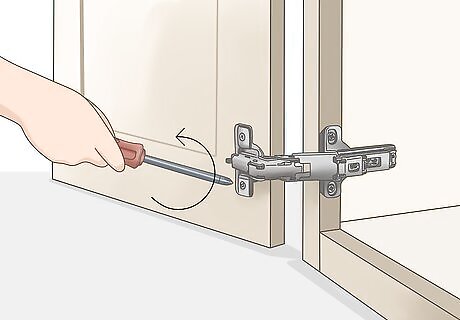
Remove hinges from the cabinet to accurately measure them. Use a Phillips head screwdriver to remove the screws pinning each hinge to the door. Hinges generally have at least 4 screws that come loose when turned counterclockwise. Take down each hinge you plan on measuring and spread them across a flat surface. Typically, all of a door’s hinges are the same size, so measuring one is enough. If you have a stuck hinge due to paint buildup, cut through the paint with a utility knife. Then, use a flathead screwdriver to pry the hinge off the cabinet. Although you can attempt to measure hinges while they are on cabinets, you are more likely to get an accurate result after you remove them.

Measure across the entire hinge to determine its open width. Hinges have 2 sides, or leaves, separated by a vertical pin in the middle. Open the hinge up all the way to lay both leaves flat. Stretch a tape measure between the outer edges of the leaves. Use it to measure the hinge at its widest point. During this measurement, hold the tape measure over the pin in the middle of the hinge. When you shop for replacement hinges, the open width is the most common measurement used. However, keep track of other measurements for greater accuracy.
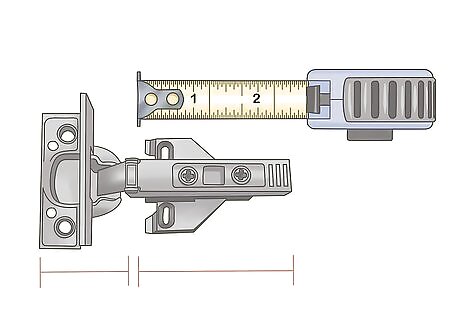
Determine the width of each leaf on the hinge. The leaf width is the distances from the central pin to the outer edge of the leaf. Depending on the type of hinge you have, the leaves may be a different size, so measure both of them. Take the measurement across the widest part of each leaf, which is usually the middle. The widths are especially important to know when the leaves aren’t equal. Hinges come in all different sizes, so you could easily end up with one that doesn't fit your cabinet style.
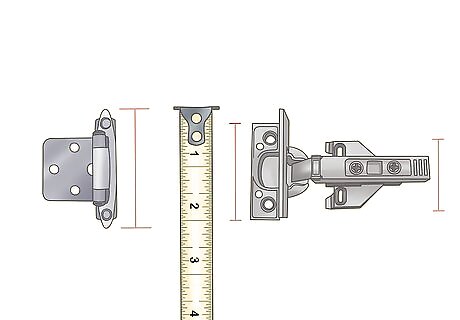
Measure the length of the hinge from top to bottom. For most hinges, the tallest part is the single pin in the center. Hold a tape measurement parallel to it to determine its height. Some hinge styles have leaves of different sizes. If your hinges are like that, measure the height of each individual leaf, noting which measurement corresponds to the door side and the cabinet side of the hinge. On uneven hinges, the cabinet-side leaf is usually bigger. Remember that it will have the bigger length and width in order to keep the hinge stable as you open and close the door.
Using Overlay to Measure the Hinge Size
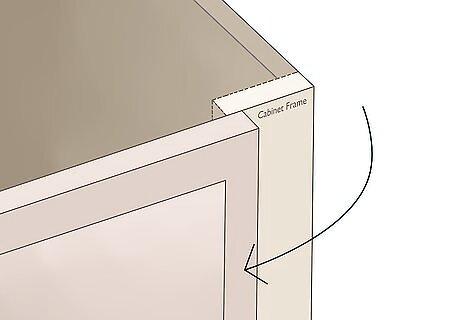
Close the cabinet door to begin measuring the door overlay. The overlay is how much a door overlaps a cabinet frame. If you need to install new hinges, measure the overlay to figure out what size you need. The cabinet door has to be closed to accurately place the tape used in the measurement. Also, not all doors have an overlay to measure. The main types of cabinet doors are overlay doors and partial insets. Overlay doors rest over the cabinet surface, while partial insets partially overlap the cabinet surface. Full inset doors are flush with the cabinet surface. They typically come on end cabinets, so measure the overlay of the other doors and get additional hinges of the same size.
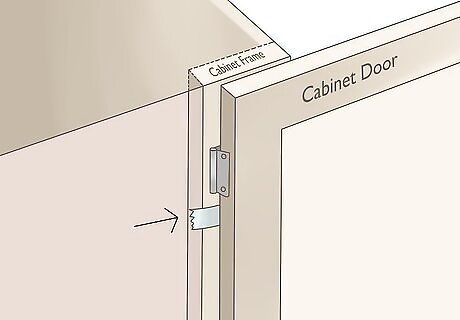
Apply a piece of tape to the hinged side of the door. Use a piece of masking tape to avoid leaving any sort of mark on your cabinets. Position the tape vertically and right up next to the hinge side of the door while it is closed. Try placing it above the lower hinge. After pressing it onto the cabinet frame, smooth it out to stick it in place. Another way to measure the overlay is by marking the edge of the door. With the door closed, make a mark along its hinge side. Use a pencil so you can erase the mark when you’re done.

Open the door to measure from the tape to the edge of the frame. After opening the door, look for the edge of the tape sticking out beneath it. It is the inside edge of the tape, closest to the hinge side of the door. If the doors haven’t been installed yet, move them to make the tape more visible. When you’re ready to measure the overlay, hold a ruler or tape measure from the tape to the inside edge of the frame. The overlay is typically ⁄4 to 1 ⁄2 in (0.64 to 3.81 cm). Some doors have a different overlay size. It depends on how the cabinets were built.
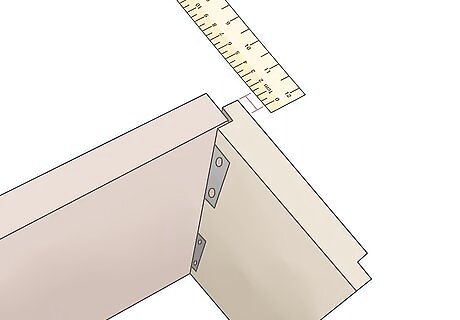
Measure the lip if you have a partial inset door. A partial inset door is one that is partially inside, or overlapping, the cabinet frame. Check by inspecting the edge of the door, particularly from above if you are able to. Then, use a ruler to measure from the edge of the door to the inner edge of the cabinet. Modern inset doors generally use ⁄4 in (1.9 cm) inset overlay hinges. There are other hinge sizes available, but they are more difficult to find.
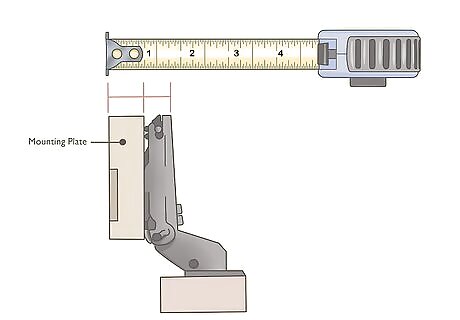
Use the overlay to determine the hinge size you need for the door. Pick a new hinge with the same overlay size to ensure it’s a good fit for your cabinet. Many hinges have the overlay amount printed on them. If a hinge doesn’t have that, use a tape measure to determine the width of the mounting plate included with the hinge or cabinet. Take the measurement across the middle part of the plate where it is widest, then add the result to the hinge width before comparing it to the overlay you measured earlier. Basically, add the mounting plate width and hinge width together. If the result equals the overlay, then you’re using the right hinge size. Hinges are available at most hardware stores, but they are also available online. If you shop online, you may be able to select an overlay size to see hinges that fit your cabinet’s doors. Mounting plates typically come included with new hinges. It’s the part that fits against the cabinet so you have a spot to attach the hinge.
Choosing a Hinge

Take the old hinge with you if you go shopping in person. Bring along any measurements you have as well. The old hinge gives you a visual representation to compare to replacement hinges before you buy them. To keep the cabinet doors working smoothly, try to pick an exact replacement. Finding a replacement can be difficult, so ask store associates for help if you can't locate what you need. Check hardware stores or furniture stores that sell cabinets. If you bring the old hinge, the employees will have an easier time recommending a replacement if you need to ask them.

Select a hinge style that works well with the type of cabinet you have. Finding replacement hinges is so much easier once you discover what style your cabinets use. Overlay and inset cabinet doors tend to require different types of hinges. Match the new hinge style to the old one to ensure a successful installation. If you wish to change styles, you could try picking one that complements the type of door your cabinets have. Mortise, or butt, hinges are one of the most common types. A butt hinge has a vertical pin between 2 leaves of the same size. They are used on many types of doors, including many overlay, partial inset, and inset doors. Face-mounted or semi-concealed hinges are for inset doors. This kind of hinge has a very small leaf on one side and a wider one on the other that attaches to the door. Surface-mount or European-style hinges are unusual since they fit inside a door. They are like long, foldable hinges with mounting plates on both ends and work well with full inset doors.
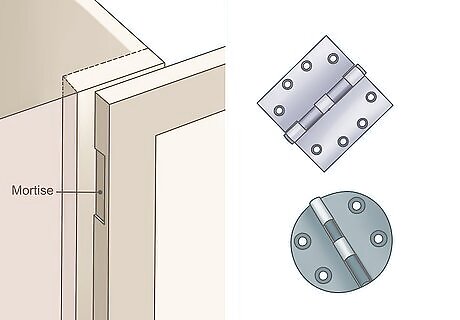
Choose a hinge shape that matches the mortise on the cabinet. A mortise is a groove cut into the cabinet door or frame. The hinge size matters, but also consider the shape. Many hinges have square edges, but there are also round ones that only fit into round mortises. To avoid having to alter the mortise and risk damage to the finish, choose the correct hinge style for your cabinet. When a hinge is the correct thickness, it will be flush with the cabinet frame. However, if it’s the wrong shape, you won’t be able to fit it into the mortise. If you don’t see any mortises, your cabinet uses no-mortise hinges. These hinges are thicker than normal so the cabinet doors are able to shut properly.
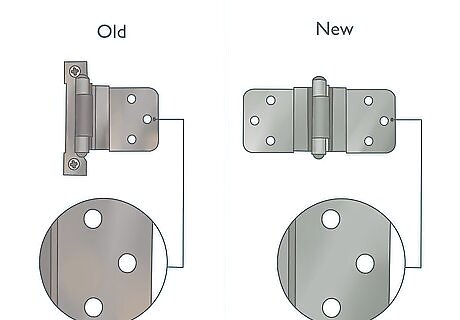
Match the screw pattern to the one used on the old hinge. A matching screw pattern reduces the amount of installation work you have to do and prevents damage to your cabinet. If the holes don't align, you have to fill them in with something like polyester wood filler and then drill new ones. You don't have to do that when the screw pattern matches. Just fit the hinge and then slot the screws into the existing holes! Filling in holes is extra work that isn’t necessary in most cases. It’s fine if you intend on using a different hinge style, but it’s better to avoid it if you don’t need to mess with the cabinet’s finish! Some cabinets also fit inside grooves etched into the door. If your cabinet has hinge grooves, take size measurements of the grooves if needed to ensure the hinges fit in them.


















Comments
0 comment